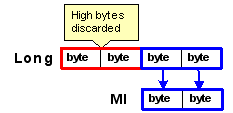Read Row
Use the Read function to select Data Table rows and read their data into PLC memory operands. Values are read from the Data Table into the operands that are linked to it in the Read function. Note that the number of rows read cannot exceed the number of rows that are in the Data Table.

Write Row
Use the Write function to select PLC memory operands and read their data into Data Table rows.
Values are read from the PLC into the Data Table cells that are linked to it in the Write function.
Note that you provide a Start Address for the PLC memory operands; the Write function will take a vector of operands that will fit the number of rows in the Data Table.






